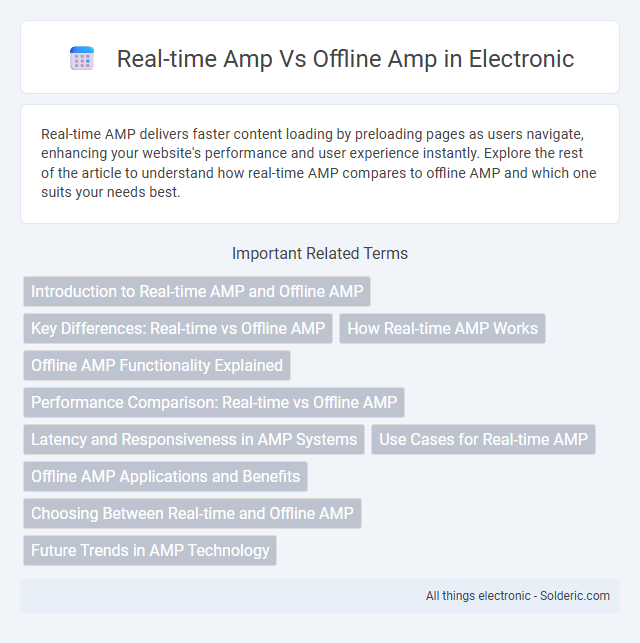Real-time AMP delivers faster content loading by preloading pages as users navigate, enhancing your website's performance and user experience instantly. Explore the rest of the article to understand how real-time AMP compares to offline AMP and which one suits your needs best.
Comparison Table
| Feature | Real-time AMP | Offline AMP |
|---|---|---|
| Definition | Accelerated Mobile Pages processed and updated instantly as data streams in. | Accelerated Mobile Pages generated and cached prior to user access without live updates. |
| Data Freshness | Immediate, reflects the latest information. | Static until next scheduled update. |
| Use Cases | Live news, stock prices, sports scores, social media updates. | Blogs, product pages, archived content. |
| Performance | Fast with dynamic loading; may require more resources. | Extremely fast due to pre-rendering and caching. |
| Implementation Complexity | Higher; requires real-time data integration and streaming. | Lower; static generation with periodic rebuilds. |
| SEO Impact | Positive if latency is low and content is fresh. | Strong due to stable, crawlable pages. |
| Examples | Push updates on live events, live blogs. | Static websites, product catalogs. |
Introduction to Real-time AMP and Offline AMP
Real-time AMP processes data instantly to deliver immediate insights and updates, essential for dynamic applications such as live user interactions and monitoring systems. Offline AMP, on the other hand, analyzes data in batches, suitable for non-urgent analytics and historical trend evaluation. Both approaches optimize data utilization by balancing speed and resource efficiency based on specific business needs.
Key Differences: Real-time vs Offline AMP
Real-time AMP processes data instantly, enabling immediate insights and faster decision-making, while offline AMP analyzes historical data stored in batches for comprehensive trend analysis. Real-time AMP supports dynamic personalization and quick reaction to events, whereas offline AMP is better suited for deep analytics and reporting. Your choice between real-time and offline AMP depends on whether you prioritize speed or in-depth data analysis.
How Real-time AMP Works
Real-time AMP processes and delivers ads instantly by analyzing user interactions and contextual data as they happen, ensuring highly relevant and personalized advertising experiences. This technology uses advanced algorithms and machine learning models to optimize ad targeting on the fly, increasing engagement and conversion rates. Your campaigns benefit from immediate adjustments to audience behavior, maximizing effectiveness compared to traditional offline AMP methods.
Offline AMP Functionality Explained
Offline AMP functionality processes data in batches rather than continuously, enabling comprehensive analysis of large datasets without the latency associated with real-time processing. This approach allows for more complex computations and historical trend analysis, making it ideal for strategic decision-making and reporting. Your choice between real-time and offline AMP depends on whether immediate insights or in-depth data evaluations are prioritized.
Performance Comparison: Real-time vs Offline AMP
Real-time AMP delivers faster page load times by processing data instantly, enhancing user experience through immediate content updates and lower latency. Offline AMP relies on pre-rendered pages stored on servers, which can result in slower interactions when dynamic content needs refreshing. Your site's performance benefits more from real-time AMP if you require frequent content changes and improved responsiveness.
Latency and Responsiveness in AMP Systems
Real-time AMP systems provide minimal latency, enabling instantaneous processing and immediate feedback crucial for applications such as live monitoring and dynamic control. Offline AMP systems prioritize complex, resource-intensive analyses that tolerate higher latency, resulting in less responsiveness but more comprehensive data processing. The trade-off between latency and computational depth defines the choice between real-time and offline AMP solutions based on specific operational demands.
Use Cases for Real-time AMP
Real-time AMP is ideal for use cases requiring instantaneous data updates and dynamic content delivery, such as live sports scores, stock market dashboards, and real-time social media feeds. It enables seamless user experiences by updating essential information without page reloads, crucial for engagement in high-frequency trading platforms or live event coverage. Your website benefits from increased responsiveness and relevancy when leveraging real-time AMP for applications demanding immediate feedback and interaction.
Offline AMP Applications and Benefits
Offline AMP applications include static site generation, content pre-rendering, and email marketing templates, which enable fast loading and improved user experience without relying on live server responses. These applications benefit from reduced server load, enhanced SEO performance due to pre-rendered content, and consistent display across devices regardless of internet connectivity. Offline AMP is particularly advantageous for mobile users in regions with limited network access, ensuring accessibility and swift content delivery.
Choosing Between Real-time and Offline AMP
Choosing between Real-time AMP and Offline AMP depends primarily on your project's need for immediacy versus thoroughness. Real-time AMP processes data instantly, enabling you to respond quickly to dynamic environments, while Offline AMP allows for detailed analysis and batch processing of accumulated data to enhance accuracy. Your decision should balance speed requirements and the complexity of data processing to optimize performance and user experience.
Future Trends in AMP Technology
Real-time AMP technology is rapidly evolving with advancements in AI-driven content personalization and instant data processing, enabling more dynamic user experiences. Offline AMP continues to improve with enhanced caching and preloading mechanisms, reducing load times and providing seamless access even in low-connectivity environments. Your website's future success depends on integrating these evolving AMP trends to balance speed, interactivity, and accessibility.
Real-time amp vs Offline amp Infographic

 solderic.com
solderic.com